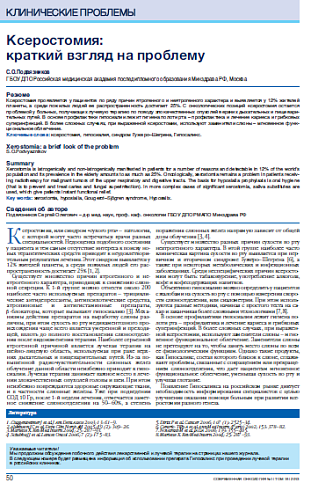Материалы доступны только для специалистов сферы здравоохранения.
Чтобы посмотреть материал полностью
Авторизуйтесь
или зарегистрируйтесь.
Ксеростомия: краткий взгляд на проблему
Ксеростомия: краткий взгляд на проблему
Материалы доступны только для специалистов сферы здравоохранения.
Чтобы посмотреть материал полностью
Авторизуйтесь
или зарегистрируйтесь.
Аннотация
Ксеростомия проявляется у пациентов по ряду причин ятрогенного и неятрогенного характера и выявляется у 12% жителей планеты, а среди пожилых людей его распространенность достигает 25%. С онкологических позиций ксеростомия остается проблемой у больных, получающих лучевую терапию по поводу злокачественных опухолей верхних дыхательных и пищеварительных путей. В основе профилактики гипосиалии лежит гигиена полоти рта – профилактика и лечение кариеса и грибковых суперинфекций. В более сложных случаях, при выраженной ксеростомии, используют заменители слюны – мгновенное функциональное облегчение.
Ключевые слова: ксеростомия, гипосиалия, синдром Гужеро–Шегрена, Гипосаликс.
Key words: xerostomia, hyposialia, Gougerot-Sjögren syndrome, Hyposalix.
Ключевые слова: ксеростомия, гипосиалия, синдром Гужеро–Шегрена, Гипосаликс.
________________________________________________
Key words: xerostomia, hyposialia, Gougerot-Sjögren syndrome, Hyposalix.
Полный текст
Список литературы
1. Guggenheimer J et al. J Am Dent Assos 2003; 13: 61–9.
2. Altkinson JC et al. Dent Clin North AM 2005; 49 (2): 309–26.
3. Mariette X. Rev Med Intern 2004; 25: 287–93.
4. Sciubba JJ et al. Lancet Oncol 2006; 7 (2): 175–83.
5. Dirix P et al. Cancer 2006; 107 (1): 2525–34.
6. Gentric-Tilly A et al. Ann Med Intern (Paris) 2002; 153: 378–82.
7. Novaresh M et al. JADA 2008; 139: 355–405.
8. Mariette X. Rev Med Intern 2004; 25: 287–93.
2. Altkinson JC et al. Dent Clin North AM 2005; 49 (2): 309–26.
3. Mariette X. Rev Med Intern 2004; 25: 287–93.
4. Sciubba JJ et al. Lancet Oncol 2006; 7 (2): 175–83.
5. Dirix P et al. Cancer 2006; 107 (1): 2525–34.
6. Gentric-Tilly A et al. Ann Med Intern (Paris) 2002; 153: 378–82.
7. Novaresh M et al. JADA 2008; 139: 355–405.
8. Mariette X. Rev Med Intern 2004; 25: 287–93.
Авторы
С.О.Подвязников
ГБОУ ДПО Российская медицинская академия последипломного образования Минздрава РФ, Москва
ГБОУ ДПО Российская медицинская академия последипломного образования Минздрава РФ, Москва
________________________________________________
Цель портала OmniDoctor – предоставление профессиональной информации врачам, провизорам и фармацевтам.

